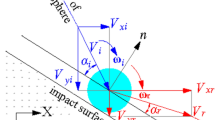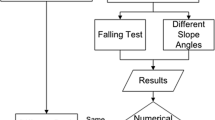Abstract
Rockfalls have disastrous consequences on human activities; therefore their study is necessary in order to design effective protection measures. The design of mitigation measures (barriers etc.) is based on trajectory analyses, which depend, amongst other parameters, on the coefficients of restitution. These describe the response of a block to an impact with the slope and are often considered only a function of the falling rock. In the present study, laboratory tests were performed in order to examine the effect of weathering of the slope’s surface on the value of the coefficients of restitution. Samples from Athens schist with different weathering grades were used and the falling blocks were cast spheres made of high-strength cement grout. The incidence angles varied between 20o and 90o. The coefficients of restitution were determined for each test using a high-speed camera and a specialized machine vision computer code developed in Matlab. The values of the kinematic coefficient of restitution were found to decrease with increasing weathering degree. The kinematic coefficient of restitution is preferable for use in rockfall trajectory analysis since no correlation between the normal or tangential coefficients of restitution and weathering of the surface were found.
Access provided by Autonomous University of Puebla. Download conference paper PDF
Similar content being viewed by others
Keywords
1 Introduction
Rockfalls are particularly usual in steep mountainous terrain and have disastrous effects on infrastructure and human lives. They are generally initiated by climatic or biological events that cause a change in the forces acting on a rock (Hoek 2000). Additionally, they can be triggered by earthquakes or human activities. The trajectory analysis of rockfalls is necessary for the dimensioning of mitigation measures.
Rockfall trajectory is characterized by four different modes of movement: free-fall, bouncing, rolling and sliding (Descoeudres and Zimmermann 1987). Bouncing is particularly complex and thus difficult to predict. In most trajectory analysis software, it is solely approached by either the kinematic or the normal and tangential coefficients of restitution (COR), which are often considered only as a function of the properties of rock material; without consideration of other parameters that may affect them, such as the geological and morphological characteristics of both the falling block and the slope or the kinematic state of the falling block.
During the impact of a block with a slope surface, force is applied from the block on the surface and its reaction makes it bounce towards the opposite direction. The trajectory characteristics after the impact (bouncing height, velocity, etc.) depend on the circumstances during impact (incidence velocity and angle, mass, shape, configuration, etc.).
Various models have been proposed to describe the impact mechanism. The lumped-mass model, where the response to an impact is described by the COR values is mostly used due to its simplicity. The generic definition, originating from Newton’s theory for the inelastic collision of particles, is written in terms of velocities. The kinematic COR of a block impacting on a rigid surface, is defined as:
where vi = pre-impact (incidence) block velocity; vr = post-impact block velocity and vCOR = kinematic coefficient of restitution.
From the normal and tangential projections of the velocity vectors, with respect to the slope’s surface, the following definitions have been adopted.
where the subscripts after the comma n = normal component; t = tangential component; nCOR = normal COR and tCOR = tangential COR.
The aforementioned expressions regard the translational velocity of the block center while the angular velocity is neglected.
An overview of the available models describing the response to an impact is presented by Heidenreich (2004), Bourrier and Hungr (2011) and others. Such models are usually software-specific and not very common.
The determination of COR values can be done by back analyses of known rockfall trajectories, field and laboratory tests (Paronuzzi 2009). Based on results of experimental investigations it is known that COR values depend on various parameters, such as the shape and the size of the blocks, the inclination and the roughness of the slope, the mechanical properties of the colliding entities, as well as the kinematics of the impact (i.e. translational and rotational velocities, incidence angle and the configuration of the block at impact).
2 Experimental Setup
The present study aimed to investigate the effect of weathering on COR values. For this purpose three smooth surfaces of Athens Schist with different degree of weathering were used as impacting surfaces. Schmidt hammer rebound hardness (RL) and point load strength index (Is50) were determined for different degrees of weathering according to ISRM suggested methods (ISRM 2007) and presented in Table 363.1.
The falling blocks were cast spheres consisting of a high strength cement based grout with a diameter of ~40 mm. The surfaces on which the impacts were performed were embedded in the same material in order to acquire a standard base, adjustable in a prototype apparatus developed in the laboratory. The incidence angles for each surface were 20o, 45o, 60o (parabolic drops) and 90o (free-fall drops).
The trajectory of the falling block was recorded by a high speed video camera acquiring 500 fps. The videos were then processed with the aid of a computer machine vision code developed in MatLab. The computer code tracks the falling block for each frame, determines the point of impact and calculates the pre- and post-impact block velocities, based on which the COR values were determined. A schematic representation of the calculated trajectory parameters is presented in Fig. 363.1a whereas the output of the tracking algorithm is shown in Fig. 363.1b. Further details on the machine vision code can be found in Asteriou et al. (2013a).
Twelve (12) test series with 12 repetitions for each test set were conducted for different degrees of weathering of the impact surface or different incidence angles (thus resulting in 144 tests). The graphs presented hereafter include only the mean value and the standard deviation.
3 Results Evaluation
The kinematic COR values increase as the surface’s Schmidt hammer values (RL) increase as presented in Fig. 363.2. This is more evident for the larger values of incidence angles. Previous studies proved that the kinematic COR values increase with increasing Schmidt hammer values (Asteriou et al. 2013b).
The results of the present study show that the kinematic COR values decrease as the surface’s weathering increases. This is anticipated since Schmidt hammer values and surface weathering are inversely related (McCaroll 1991). A similar trend is evident for the point load strength index (Is50) as presented in Fig. 363.3, considering that the effect of weathering is described by the point load strength index values (Papadopoulos and Marinos 1992).
The normal coefficient of restitution (nCOR) values present a large scatter while the tangential coefficient of restitution (tCOR) has little variation, implying that it’s not affected by the surface weathering. Therefore, no correlation between normal or tangential COR values and surface weathering can be expressed.
Kinematic COR values relative to the incidence angle of the falling block are presented in Fig. 363.4 and it is evident that COR values are inversely related to the incidence angle. This is attributed to the fact that as the impact approaches the perpendicular position to the surface more energy dissipates, resulting to lower COR values (Asteriou et al. 2012).
Normal COR values present a large scatter thus no conclusion can be drawn on the effect of the incidence angle on this parameter. Additionally, tangential COR values do not show variation, implying that they are not influenced by the incidence angle.
4 Conclusions
The effect of slope’s weathering on the response of a block during a rockfall was investigated based on an experimental procedure on samples of Athens schist. Rock weathering was described by Schmidt hammer hardness and point load strength index as well as characterized according to ISRM suggested methods.
The kinematic COR values decrease as the degree of weathering of the impact surface increases. Moreover, the increase in values of surface properties, such as the point load strength index and Schmidt hammer rebound value, which express an increase of surface weathering, seem to be directly proportional to the value of the kinematic COR. Kinematic COR values also decrease with increasing incidence angles, denoting that as the impact approaches the perpendicular position to the surface more energy is dissipated.
Normal COR values have a large scatter, thus the incidence angle has a significant effect and tangential COR values remain unchanged regardless of the characteristics of the surface, or the incidence angles. These conclusions are in good agreement with literature findings, according to which the tangential COR is stated to be insensitive in changes of the incidence conditions or the material properties.
Based on the present study, when examining the effect of surface characteristics, such as weathering, it is preferable to study the kinematic COR rather than the normal or tangential components since the correlations between the coefficient and the degree of weathering appear to be more consistent.
References
Asteriou P, Saroglou H, Tsiambaos G (2012) Geotechnical and kinematic parameters affecting the coefficients of restitution for rock fall analysis. Int J Rock Mech Mining Sci 54:103–113
Asteriou P, Saroglou H, Tsiambaos G (2013a) Rockfall: scaling factors for the coefficient of restitution. In: Proceedings of EUROCK2013—The 2013 ISRM international symposium, pp 195–200
Asteriou P, Saroglou H, Tsiambaos G (2013b) Rockfalls: influence of rock hardness on the trajectory of falling rock blocks. Bulletin of the Geological Society of Greece, Greece, XLVII
Bourrier F, Hungr O (2011) Rockfall dynamics: a critical review of collision and rebound models. In: Lambert S, Nicot F (eds) Rockfall engineering. Wiley – ISTE, Hoboken
Descoeudres F, Zimmermann T (1987) Three-dimensional dynamic calculation of rockfalls. In: Proceedings of the 6th congress international society for rock mechanics, Montreal, 1987, vol 1, pp 337–342
Heidenreich B (2004) Small- and half-scale experimental studies of rockfall impacts on sandy slopes. Ph.D Thesis, EPFL
Hoek E (2000) Analysis of rockfall hazards. www.rocscience.com
ISRM (2007) The complete ISRM suggested methods for rock characterization, testing and monitoring: 1974–2006. Pergamon Press, Oxford
McCaroll D (1991) The Schmidt hammer, weathering and rock surface roughness. Earth Surf Proc Land 18:526–539
Papadopoulos Z, Marinos P (1992) On the anisotropy of the Athenian schist and its relation to weathering. Bull Int Assoc Eng Geol 45:111–116
Paronuzzi P (2009) Field evidence and kinematical back-analysis of block rebounds: The lavone rockfall, Northern Italy. Rock Mech Rock Eng 42:783–813
Author information
Authors and Affiliations
Corresponding author
Editor information
Editors and Affiliations
Rights and permissions
Copyright information
© 2015 Springer International Publishing Switzerland
About this paper
Cite this paper
Giokari, S., Asteriou, P., Saroglou, C., Tsiambaos, G. (2015). Rockfalls: Effect of Slope Surface Weathering on the Coefficients of Restitution. In: Lollino, G., et al. Engineering Geology for Society and Territory - Volume 2. Springer, Cham. https://doi.org/10.1007/978-3-319-09057-3_363
Download citation
DOI: https://doi.org/10.1007/978-3-319-09057-3_363
Published:
Publisher Name: Springer, Cham
Print ISBN: 978-3-319-09056-6
Online ISBN: 978-3-319-09057-3
eBook Packages: Earth and Environmental ScienceEarth and Environmental Science (R0)








